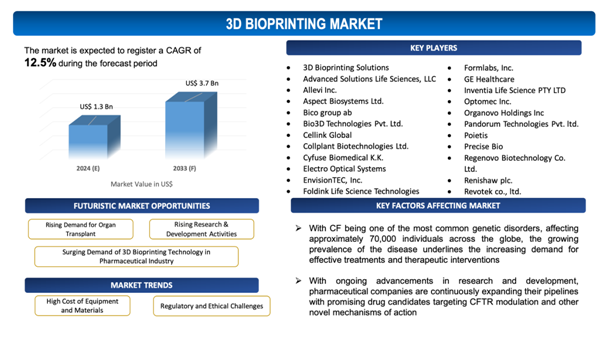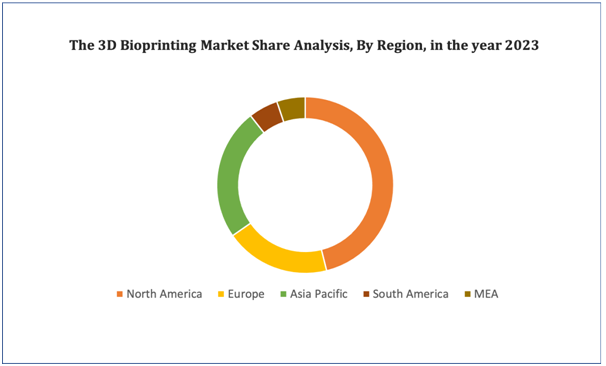3D Bioprinting Market Overview
The global 3D Bioprinting market is estimated to be worth over USD 3.7 Bnin 2033 and is expected to grow at CAGR of 12.5% during the forecast period (2024-2033).
3D bioprinting serves at the forefront of revolutionary technologies, transformingdifferent fields, including pharmaceuticals, medicine, and tissue engineering, in recent times. This pioneering technique allows the precise layer-by-layer deposition of biomaterials, living cells, and bioactive molecules to generateintricate three-dimensional structures imitating native tissues and organs.
One of the most considerable impacts of 3D bioprinting is its potential to transform regenerative medicine by allowing the fabrication of patient-specific tissues and organs for transplantation. This commits to address the crucial shortage of donor organs and minimize the risks related to transplantation, such as rejection and immunosuppression. In addition, 3D bioprinting supports the development of innovative in vitro models of human organs, known as organoids, which provide unprecedented insights into disease mechanisms, drug efficacy, and toxicity. These organoids serve as robust tools for drug discovery, personalized medicine, and the study of intricate diseases, leading the way for more effective therapies and precision treatments.
Moreover, 3D bioprinting holds commitment in the field of tissue engineering, enabling for the creation of bespoke implants, scaffolds, and prosthetics customized to individual patient needs. This not only improves the success rates of surgeries but also enhances patient outcomes and quality of life.
On top of that, 3D bioprinting is fuelling innovation in the production of pharmaceuticals, allowing the fabrication of customized drug delivery systems and tissue-specific drug testing platforms. Since research and development in 3D bioprinting continue to advance, the technology stands ready to revolutionize healthcare delivery, from regenerative medicine and personalized therapeutics to disease modelling and drug development, directing in a new age of precision medicine and patient care.
Figure 1. 3D Bioprinting: Market Size

Get more details on this report - Request Free Sample
Key Market Insights &Current Market Landscape
The global 3D bioprinting market is swiftlyprogressing, fuelled by substantial advancements and novel technologies that are redefining the panorama of pharmaceuticals, medical research, and regenerative medicine. The market exhibits robust growth prospects, driven by growing demand for personalized medicine, tissue engineering, and the rising incidence of chronic diseases. Prominent developments comprise the improvement of bioprinting methods, such as the incorporation of microfluidics for more precise cell placement and the use of bio-inks that imitate natural tissue environments in more detail.
Novel technologies in the market are pushing the limits of what 3D bioprinting can achieve. For instance, advancements in multi-material bioprinting allow for the simultaneous printing of different cell types and materials, enabling the creation of more complex and functional tissues. In addition, the development of bioprinting platforms that integrate real-time imaging and feedback systems has notablyenhanced the viability and accuracy of printed tissues.
The market is also witnessing increased collaboration between academic institutions, research organizations, and biotech companies, accelerating innovation and commercialization of bioprinting technologies. These collaborations are crucial for overcoming technical barriers and ensuring the scalability and affordability of Bio-printed products. As these technologies continue to evolve, the global 3D bioprinting market is poised for significant growth, with the potential to transform healthcare by providing cutting-edge solutions for tissue regeneration, disease modelling, and drug testing.
Market Dynamics
Market Drivers
Surging Demand of 3D Bioprinting Technology in Pharmaceutical Industry
The growing adoption of 3D bioprinting technology in the pharmaceutical industry is a notable market driver for the global 3D bioprinting market, as it transforms drug development and personalized medicine. This technology allows pharmaceutical companies to create highly accurate and reproducible tissue models that meticulouslyimitate human biology. These state-of-the-art models are essential in improving the drug discovery process, enabling for more precise screening of drug candidates and lowering the reliance on animal testing. By offering a more relevant human tissue context, 3D bioprinting aids in determining potential drug efficacy and toxicity issues beforehand in the development pipeline, thuspropelling the pace of drug discovery and mitigating costs.
In addition, 3D bioprinting promotes the manufacturing of customized drug delivery systems and patient-specific implants, personalizing treatments to individual patient needs. This level of personalization is particularly beneficial in the development of treatments for complex diseases such as cancer, where patient-specific tumour models can be Bio-printed to test the efficacy of various therapies, resulting in more effective and targeted treatment strategies.
The technology also facilitates the creation of organ-on-a-chip systems, which duplicate the functions of human organs and offer a powerful platform for studying disease progression and drug responses in a controlled environment. These innovations substantiallyimprove the pharmaceutical industry's capability to conduct high-throughput screening and detailed mechanistic studies.
As pharmaceutical companies continue to incorporate 3D bioprinting into their R&D processes, the demand for bioprinting technologies and materials is expected to surge. This soaring adoption not only boosts the market growth of 3D bioprinting but also stimulates further technological breakthroughs, ultimately resulting in more effective and safer therapeutic solutions for patients globally.
Market Restraints
With regard to numerous advantages of 3D Bioprinting, the market faces several challenges due to the unique characteristics and requirements associated with these potent pharmaceutical products. Some of the key market challenges include:
- High Cost of Equipment and Materials: The progressive nature of 3D bioprinting technology requiressignificant investment in high-precision equipment and specialized bio-inks, which can be prohibitively overpriced. This high cost hindrance can impede adoption, specifically among smaller research institutions and emerging biotech companies, thusimpeding market growth.
- Regulatory and Ethical Challenges: The development and application of 3D bioprinting technology witnessmajor regulatory and ethical hurdles. Ensuring the safety, efficiency, and ethical considerations of Bio-printed tissues and organs comprises navigating intricate regulatory frameworks, which can delay product development and commercialization. This uncertainty and potential for stringent regulatory scrutiny can hamper the growth of the global 3D bioprinting market.
Market Opportunity
Rising Demand for Organ Transplant
With a serious shortage of donor organs across the world, millions of patients are left on waiting lists, commonly facing prolonged delays and high risks related to organ failure. 3D bioprinting provides a revolutionary solution by allowing the creation of bioengineered tissues and organs personalized to individual patient requirements. This technology can potentially reduce the organ shortage crisis by generating viable, transplantable organs, thereby saving innumerable lives and minimizingreliability on donor availability.
Additionally, 3D bioprinting can reduce issues associated with organ rejection. By using a patient's own cells to bio-print tissues and organs, the risk of immune rejection is significantly lowered, enhancing the success rate of transplants. This personalized approach not only improves patient outcomes but also reduces long-term healthcare costs associated with immunosuppressive therapies and post-transplant complications.
Along with addressing the shortfall of organs, 3D bioprinting facilitates advancements in regenerative medicine, allowing the repair and regeneration of damaged tissues. This expands the scope of medical treatments and opens new prospects for clinical applications, further accelerating market growth.
Market Trends
- Advancements in Bio-ink Formulations: The development of advanced bio-inks that thoroughlyimitate the natural extracellular matrix is a remarkable trend driving the growth of the global 3D bioprinting market. These advanced bio-inks improve cell viability, differentiation, and functionality in bio printed tissues, making them more effective for complicated tissue engineering applications and surging their adoption in medical research and regenerative medicine.
- Integration of AI and Machine Learning: The integration of artificial intelligence (AI) and machine learning into 3D bioprinting processes is another emerging trend. These technologies allow more precise control over the bioprinting process, optimize print parameters, and enhance the precision of tissue constructs. AI-driven bioprinting can substantiallylessen trial-and-error phases, accelerate the development of viable bio printed organs, and personalize treatments, thusaccelerate market growth.

Get more details on this report - Request Free Sample
3D Bioprinting Market: Key Segments
By Component
- 3D Bioprinters
- Microextrusion Bioprinters
- Inkjet 3D Bioprinters
- Laser-Assisted Bioprinters
- Stereolithography-Based Bioprinters
- Magnetic 3D Bioprinters
- Others
- Bio-inks
- Natural Bio-inks
- Hybrid Bio-inks
- Synthetic Bio-inks
- Software
- Consumables
By Material
- Living Cells
- Hydrogels
- Extracellular Matrices
- Other Materials
By Application
- Research Application
- Drug Discovery & Research
- Regenerative Medicine
- 3D Cell Culture
- Tissue Engineering
- Clinical Applications
- Skin
- Bone and Cartilage
- Blood Vessels
- Other Clinical Applications
By End User
- Academic & Research Institutes
- Pharmaceutical & Biotechnology Companies
- Hospitals
By Key Geographical Regions
- North America
- Europe
- Asia-Pacific
- Middle East and Africa
- South America
Figure 4. 3D Bioprinting Market: Distribution by Region

Get more details on this report - Request Free Sample
3D Bioprinting Market: Regional Analysis
North America dominates the 3D bioprinting market attributing to the integration of IT in the healthcare industry and soar in spending by government on research and development in the region. Asia-Pacific is expected to witness high growth during the forecast period owing to the growing the mortality rate due to COVID-19 and the shortage of organ donors in the region.
3D Bioprinting Market: Recent Developments
- In October 2023, CELLINK, a global leader in bioprinting technologies, is proud to announce a pioneering innovation in the field of regenerative medicine and tissue engineering with the launch of CELLINK Vivoink, the first-ever medical-grade bio-ink specially designed to support researchers on their clinical translational journey. CELLINK Vivoink is optimized for superior printability, mechanical stability, and cell viability, making it a game-changer in the bioprinting industry.
Leading 3D Bioprinting Developers
Industry Trends and Global Forecasts, 2023-2035 report features an extensive study of the current market landscape, market size and future opportunities associated with the 3D Bioprinting market, during the given forecast period. Further, the market report highlights the efforts of several stakeholders engaged in this rapidly emerging segment of the biopharmaceutical industry. Key takeaways of the 3D Bioprinting market are briefly discussed below.
The report includes the list of players operating in the global 3D Bioprinting market. Some of the key players include:
- 3D Bioprinting Solutions
- Advanced Solutions Life Sciences, LLC
- Allevi Inc.
- Aspect Biosystems Ltd.
- Bico group ab
- Bio3D Technologies Pvt. Ltd.
- Cellink Global
- Collplant Biotechnologies Ltd.
- Cyfuse Biomedical K.K.
- Electro Optical Systems
- EnvisionTEC, Inc.
- Foldink Life Science Technologies
- Formlabs, Inc.
- GE Healthcare
- Inventia Life Science PTY LTD
- Optomec Inc.
- Organovo Holdings Inc
- Pandorum Technologies Pvt. ltd.
- Poietis
- Precise Bio
- Regenovo Biotechnology Co. Ltd.
- Renishaw plc.
- Revotek co., ltd.
- Rokit Healthcare, inc.
- Stratasys Ltd.
- Vivax Bio, LLC
Scope of the Report
The market report presents an in-depth analysis of the various firms / organizations that are engaged in this market, across different segments, as defined in the below table:
|
Key Report Attributes |
Details |
|
Base Year |
2023 |
|
Forecast Period |
2024-2033 |
|
CAGR (2024-2033) |
12.5% |
|
Component |
|
|
Material |
|
|
Application |
|
|
End User |
|
|
Key Geographical Regions |
|
|
Key Companies Profiled |
|
